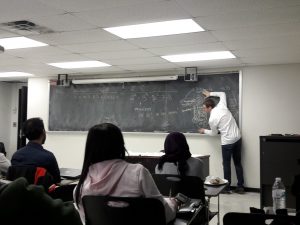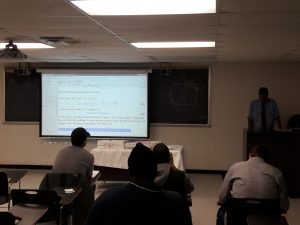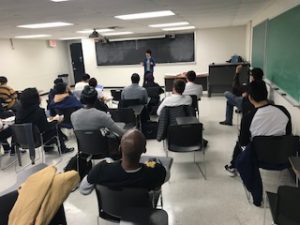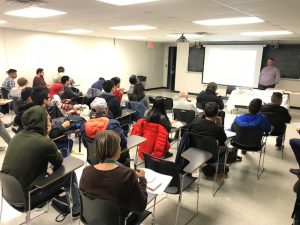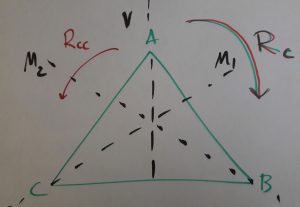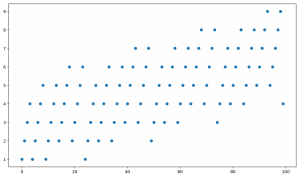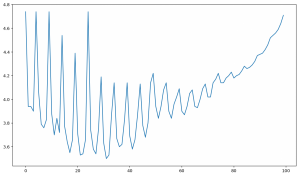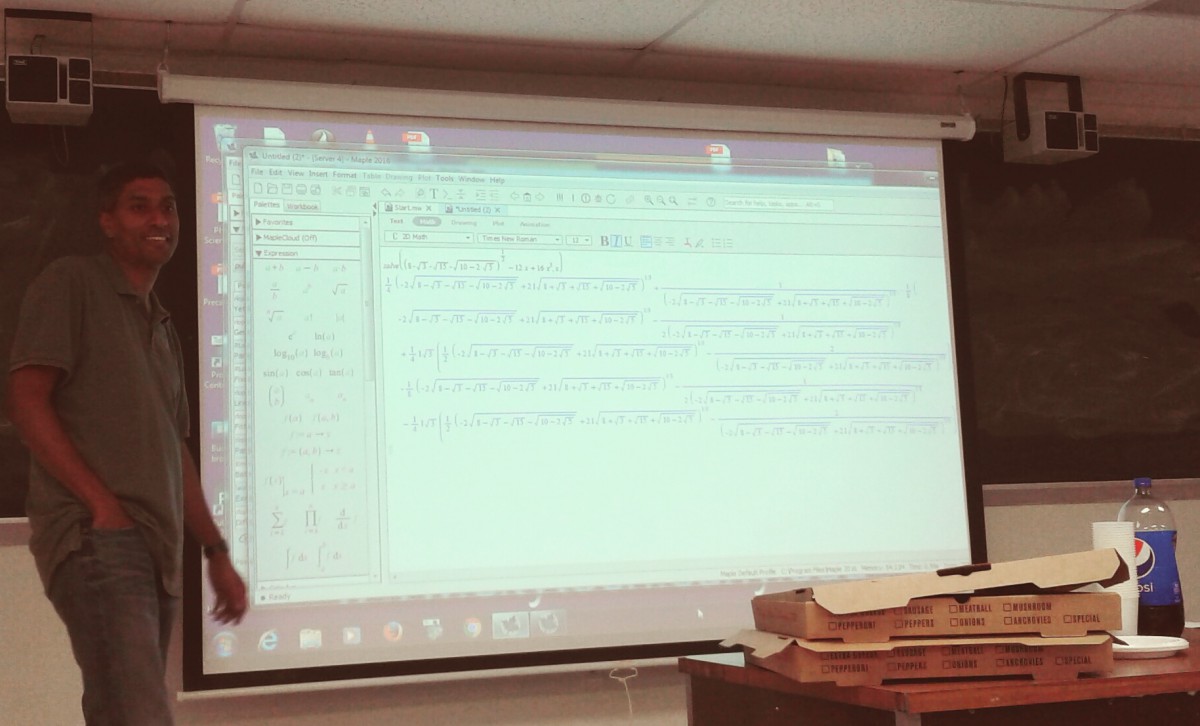Date: March 8, 2018Speaker: Dr. Thomas Johnstone (NYCCT)Title: Is the product of any k many consecutive integers always divisible by k factorial?Abstract: Recall that “k factorial” is defined as the product of all integers between 1 and k, inclusive. There are many examples when the product of k many consecutive integers is divisible by k factorial. For instance, if k=5, then the product of the five consecutive integers 12, 13, 14, 15, 16 is divisible by five factorial: indeed, 12*13*14*15*16=524160, which is divisible by 1*2*3*4*5=120.In this talk, we will answer the question whether the product of k many consecutive integers is always divisible by k factorial. While this question can be answered using combinatorial arguments, we shall rely on elementary number-theoretic arguments such as basic divisibility rules only.
“Making the Perfect Billiard Shot” by Satyanand Singh
Date: February 20, 2018Speaker: Dr. Satyanand Singh (NYCCT)Title: Making the Perfect Billiard ShotAbstract: Come sharpen your billiard skills with the help of tools from elementary geometry. This fun presentation will show you how to make a perfect shot. This talk is accessible to students with a basic knowledge of algebra and trigonometry.
“Let’s Play Sudoku!” by Brad Isaacson
Title: Let’s Play Sudoku!
Speaker: Brad Isaacson (NYCCT)
Date/Time/Location: February 8, 2018, 12:50-2:00pm, N720
Abstract:
Sudoku is a very popular number puzzle. In this talk, we will discuss some of the strategies for playing Sudoku, including naked and hidden pairs/triples, unique rectangles, and alternating inference chains. May there never again be a Sudoku puzzle that you are unable to solve.
“ECLIPSED” by Arthur Kramer
Title: ECLIPSED
Speaker: Arthur Kramer (NYCCT)
Date/Time/Location: December 14, 2017, 12:50-2:00pm, N720
Abstract:
In light of the recent sensational Solar eclipse across the US, this talk will examine the phenomenon of Solar and Lunar eclipses and the speaker’s experience observing the one in August 2017. We will look at some of the history and the the early scientific understanding of the motions of the Earth, Sun and Moon including the causes and the different types of eclipses. Some of the mathematics associated with eclipses will be presented and several of the past spectacular eclipses will be discussed including the famous one in 1919 that proved Einstein’s gravitational theory of the bending of light. The talk will conclude with information on future eclipses and how to best plan to see them.
“Becoming a Data Scientist: Skills, Interviews, and Industries” by Gerry Song
Title: “Becoming a Data Scientist: Skills, Interviews, and Industries”
Speaker: Gerry Song (Capital One)
Date\Time\Location: November 30, 2017, 12:50-2pm, N720
Abstract:
Data science is a currently a popular term, but what does it mean? How does one become a data scientist? What kind of work does one do as a data scientist? In this talk we will go over these questions and more.
“Calculus: WHY Differentiation Rules Work The Way They Do” by Thomas Johnstone
Title: “Calculus: WHY Differentiation Rules Work The Way They Do”
Speaker: Thomas Johnstone (NYCCT)
Date\Time\Location: November 16, 2017, 12:45-2pm, N719
Abstract:
You know HOW to find the derivatives of trigonometric, exponential, logarithmic, and radical functions. You know HOW to apply the power rule, the sum rule, the constant multiple rule, the product rule, and the chain rule. But do you wonder WHY any of these rules work the way they do? This talk will be accessible for anyone who is familiar with the basic differentiation rules of calculus, and the talk aims to shed light on the question why these rules work the way they do.
“The Symmetric Group and Fair Division: Does Knowledge Matter?” by Brian Hopkins
Title: “The Symmetric Group and Fair Division: Does Knowledge Matter?”Speaker: Brian Hopkins (Saint Peter’s University)Date/Room: Thursday Nov. 9, 2017, 12:00-1:00pm, Namm N720Abstract:Sports drafts and divorce settlements are examples of situations where players take turns selecting indivisible goods. Like other topics in fair division, the situation is made more interesting because people may value the goods in different ways. In this talk, we focus on the case of two players, where the machinery of permutations is surprisingly applicable. How many possible outcomes are there? In what circumstances do both players get their best possible outcomes? How can one best take advantage of knowing the other’s preferences? What happens when a player’s motivation switches from greed to spite, the common good, or selfless altruism? In this colorful talk, we’ll sample some applied algebraic combinatorics and address these issues along with the provocative question of the title.
This talk probably broke the record for the highest attendance for a Math Club talk. (talk slides)
“Introduction to Groups” by Johann Thiel
Title: “Introduction to Groups”Speaker: Johann Thiel (NYCCT)Date/Room: Thursday Oct. 26, 2017, 12:45-2:00pm, Namm N719Abstract:A group is an important mathematical structure in abstract algebra. In this talk we will introduce some of the definitions needed to understand basic group theory (with lots of examples) and talk about some important applications.
Below is an image of the symmetries of an equilateral triangle. What is the group structure here?
October 12, 2017: “The Coin Change Problem” by Johann Thiel
Title: “The Coin Change Problem”Speaker: Johann Thiel (NYCCT)Date/Room: Thursday Oct. 12, 2017, 12:45-2:00pm, Namm N719
Abstract:What is the minimum number of coins needed to give someone 82 cents in change? There is a simple algorithm that solves this question for our current coin system using pennies, nickels, dimes, and quarters. (Can you figure out the algorithm?)The more general form of this question is called the Coin Change Problem: given a list of coin denominations and a change amount, what is the minimum number of coins needed to make the change amount?In this talk we will apply dynamic programming techniques to this problem. In particular, this talk will feature some Python programming.
September 28, 2017: “A look at the radical side of trigonometry” by Dr. Satyanand Singh
Dr. Singh’s abstract can be found below. Further details can be found in the journal article “The Sine of a Single Degree” by Travis Kowalski, which appeared in the November 2016 issue of The College Mathematics Journal; the pdf is available for download on JSTOR here.

